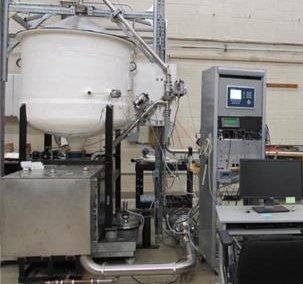Dynamic weighing method for unsteady liquid flow measurements
We are extending NIST's calibration services for liquid flow meters to higher flows at moderate cost. NIST's prototype dynamic weighing system determines the mass flow rate of water by continuously weighing a collection tank while water flows into the tank. The results have expanded uncertainties of approximately 0.03 %. (This k=2 uncertainty corresponds to a 95 % confidence level.) Customers' flow meters are calibrated with this small uncertainty even when the flow is unsteady. For details see: Feasibility of an accurate dynamic standard for water flow, Dynamic gravitational standard for liquid flow: model and measurements, or Accurately measuring unsteady water flows using a dynamic standard.

Dynamic standard for liquid flows up to 15 kg/s.
In contrast with dynamic weighing, NIST's prior calibrations determined the average mass flow rate <dm/dt> between two, static weighings of the collection tank: (1) the tank was weighed just before a flow of water is diverted from a bypass into the tank, and (2) the tank is weighed just after the flow is diverted from the collection tank back into the bypass. For the static weighing method, the timing that determines dm/dt is determined by the motion of a mechanical diverter. Because the diversion is not instantaneous, an elaborate uni-directional diverter was used to minimize timing errors. For the dynamic method, the timing that determines dm/dt is controlled by the electronics of the weigh scale and the computer that records the scale readings. Thus, the dynamic method can achieve more accurate timing while using a simple diverter or even ordinary valves to direct the flow from a bypass pipe into the collection tank. Both the electronic timing and the mechanical simplification are advantageous for measuring larger flows.
Contacts
-
(301) 975-5943

